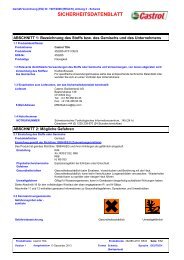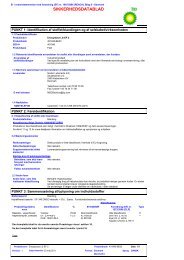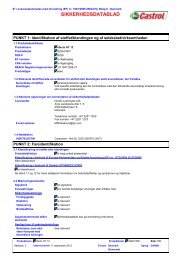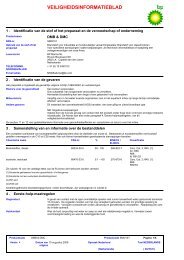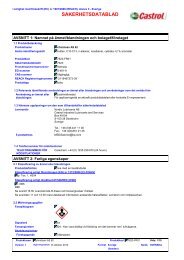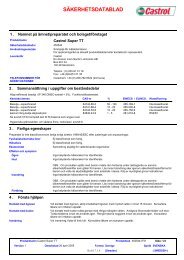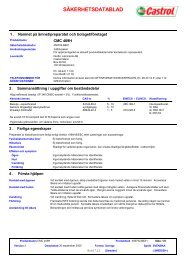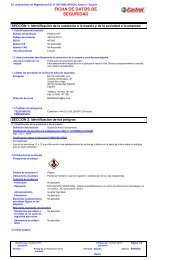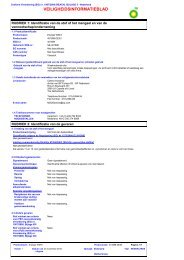219217Bartran HV 22.pdf - BP
219217Bartran HV 22.pdf - BP
219217Bartran HV 22.pdf - BP
Create successful ePaper yourself
Turn your PDF publications into a flip-book with our unique Google optimized e-Paper software.
Conforms to Regulation (EC) No. 1907/2006 (REACH), Annex II - Sweden<br />
SECTION 8: Exposure controls/personal protection<br />
Eye/face protection<br />
Skin protection<br />
Hand protection<br />
Skin and body<br />
Environmental exposure<br />
controls<br />
Respiratory protective equipment is not normally required where there is adequate natural or<br />
local exhaust ventilation to control exposure.<br />
In case of insufficient ventilation, wear suitable respiratory equipment.<br />
The correct choice of respiratory protection depends upon the chemicals being handled, the<br />
conditions of work and use, and the condition of the respiratory equipment. Safety procedures<br />
should be developed for each intended application. Respiratory protection equipment should<br />
therefore be chosen in consultation with the supplier/manufacturer and with a full assessment<br />
of the working conditions.<br />
Safety glasses with side shields.<br />
SECTION 9: Physical and chemical properties<br />
9.1 Information on basic physical and chemical properties<br />
Appearance<br />
Odour<br />
pH<br />
Physical state<br />
Colour<br />
Odour threshold<br />
Melting point/freezing point<br />
Initial boiling point and boiling<br />
range<br />
Flash point<br />
Evaporation rate<br />
Vapour pressure<br />
Vapour density<br />
Relative density<br />
Auto-ignition temperature<br />
Wear protective gloves if prolonged or repeated contact is likely.<br />
Wear chemical resistant gloves.<br />
Recommended: Nitrile gloves.<br />
The correct choice of protective gloves depends upon the chemicals being handled, the<br />
conditions of work and use, and the condition of the gloves (even the best chemically resistant<br />
glove will break down after repeated chemical exposures). Most gloves provide only a short<br />
time of protection before they must be discarded and replaced. Because specific work<br />
environments and material handling practices vary, safety procedures should be developed for<br />
each intended application. Gloves should therefore be chosen in consultation with the supplier/<br />
manufacturer and with a full assessment of the working conditions.<br />
Use of protective clothing is good industrial practice.<br />
Personal protective equipment for the body should be selected based on the task being<br />
performed and the risks involved and should be approved by a specialist before handling this<br />
product.<br />
Cotton or polyester/cotton overalls will only provide protection against light superficial<br />
contamination that will not soak through to the skin. Overalls should be laundered on a regular<br />
basis. When the risk of skin exposure is high (e.g. when cleaning up spillages or if there is a<br />
risk of splashing) then chemical resistant aprons and/or impervious chemical suits and boots<br />
will be required.<br />
Emissions from ventilation or work process equipment should be checked to ensure they<br />
comply with the requirements of environmental protection legislation. In some cases, fume<br />
scrubbers, filters or engineering modifications to the process equipment will be necessary to<br />
reduce emissions to acceptable levels.<br />
Liquid.<br />
Amber.<br />
Oily.<br />
Not available.<br />
Not available.<br />
Not available.<br />
Not available.<br />
Pour point



